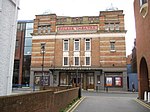Watford ( (listen)) is a town and borough in Hertfordshire, England, 15 miles northwest of Central London, on the River Colne.
Initially a small market town, the Grand Junction Canal encouraged the construction of paper-making mills, print works, and breweries. While industry has declined in Watford, its location near London and transport links has attracted several companies to site their headquarters in the town. Cassiobury Park is a public park that was once the manor estate of the Earls of Essex.
The town developed next to the River Colne on land belonging to St Albans Abbey. In the 12th century, a charter was granted allowing a market, and the building of St Mary's Church began. The town grew partly due to travellers going to Berkhamsted Castle and the royal palace at Kings Langley. A mansion was built at Cassiobury in the 16th century. This was partly rebuilt in the 17th century and another country house was built at The Grove.
The Grand Junction Canal in 1798 and the London and Birmingham Railway in 1837 resulted in Watford's rapid growth, with paper-making mills such as John Dickinson at Croxley, influencing the development of printing in the town. Two brewers, Benskins and Sedgwicks, amalgamated and flourished in the town until their closure in the late 20th century. Hertfordshire County Council designates Watford to be a major sub-regional centre. Several head offices are based in Watford. International conferences and sporting events have also taken place in Watford, including the 2006 World Golf Championship, the 2013 Bilderberg Conference and the 2019 NATO summit which all took place at The Grove.Watford became an urban district under the Local Government Act 1894 and a municipal borough by grant of a charter in 1922. The borough, which had 90,301 inhabitants at the 2011 census, is separated from Greater London to the south by Three Rivers District. Watford Borough Council is the local authority with the Mayor of Watford as its head – one of only 18 directly elected mayors in England and Wales.









